Recently, I experimented with diving a little deeper into the Book of Mormon, reading, experiencing, and examining it in an entirely new way—through text analysis.
Before you tune me out, let me assure you the process is much more fascinating than it might sound. I took the text of the Book of Mormon (not including chapter summaries that were added later) and ran each book through a program that looks at everything from the most-used words and phrases in the text to its level of readability, number of characters, longest sentence (Captain Moroni holds the record with a sentence of 135 words in Alma 60:25-27), number of syllables, etc. That’s right, I looked at detailed information regarding the entire 1,417,809 characters, 267,931 words, 7,679 sentences, and 369,797 syllables found in the Book of Mormon—pages and pages of information just waiting to provide insight and new perspective.
Here are just a few of the insights I had while investigating the Book of Mormon in this different way:
The Most-Used Word in the Book of Mormon
It’s no surprise that the most-used word in the Book of Mormon is the most-used word in almost any work of literature. It was also the most-used word of my last sentence. The word? “The.” It is used 19,203 times in the Book of Mormon, making it 7.2 percent of the entire text. But when you filter out the smaller filler words, an entirely new picture appears:

When looking at these words together, messages appear for me that are intensely deep and personal. The most-used Book of Mormon word, “unto,” signifies to me the very purpose of this sacred record. This book is meant to draw me unto the Father and His Son. It is a precious gift given unto me by my Heavenly Father and prophets of the past. Their messages speak of “the voice of the Son [coming] unto me” (2 Nephi 31:12), teaching me to “do unto others as you would have them do unto you” (Luke 6:31).
The rest of the most-used words in the Book of Mormon speak of this personal relationship with God as well as actions we must take. I love that “shall” is stressed above “not,” revealing the gospel is focused on what we do, how we create, and who we serve rather than what we refrain from. In addition to this focus on doing, many personalizing words shine through (“I,” “ye,” “all,” “people,” “my”), showing that God not only desires to reach all His children—He wants to reach us all on an intimate, individualized level. As Elder David A. Bednar says in his recently released book, One by One, “the Lord knows us one by one. He knows each of us. He knows our names. He knows our concerns. He knows our apprehensions. He knows our potential and possibilities. Significantly, the first word spoken by God the Eternal Father to man in the first vision in this latter-day dispensation was ‘Joseph.’ The Father and the Son knew Joseph Smith as a one.” And He knows each of us as a one and speaks to us through the Book of Mormon.
Simpleness of the Language
Another surprising finding from my research into the language of the Book of Mormon was its simplicity. On a readability scale (where 6 represents easy and 20 very difficult), each book within the Book of Mormon scored below an 11, with most books scoring close to an 8.
Despite the years, language, culture, and other barriers that separate us from the Book of Mormon prophets, their words still strike us with the same clarity and simplicity Nephi spoke of: “For my soul delighteth in plainness; for after this manner doth the Lord God work among the children of men” (2 Nephi 31:3), “I glory in plainness; I glory in truth; I glory in my Jesus, for he hath redeemed my soul from hell” (2 Nephi 33:6), “My soul delighteth in plainness unto my people, that they may learn” (2 Nephi 25:4).
As Elder Marvin J. Ashton taught, “More so than in any other time in our history, there is an urgency in today’s society for men and women to step forward and teach the gospel of Jesus Christ in the power of plainness. God delights when His truths are taught clearly and understandably with no conspicuous ornamentation. Plainness in life, word, and conduct are eternal virtues.” The plainness in the Book of Mormon testifies that ancient prophets truly saw our day and understood the simple truths we most need to guide our lives.
Each Author Is Distinct
From the words and phrases they use to sentence length and language complexity, each author of the Book of Mormon has a distinct voice. As Elder Tad R. Callister notes, this creates compelling proof of the Book of Mormon’s divinity.
So how did Joseph perform this remarkable feat of dictating a 500-plus–page book without any notes? To do so, he must not only have been a creative genius but also have had a photographic memory of prodigious proportions. . . .
But there is more. These arguments account only for the book’s historical content. The real issues still remain: how did Joseph produce a book that radiates with the Spirit, and where did he get such profound doctrine, much of which clarifies or contradicts the Christian beliefs of his time? . . .God’s fingerprints are all over the Book of Mormon, as evidenced by its majestic doctrinal truths, particularly its masterful sermons on the Atonement of Jesus Christ. . . .
But even if we suppose that Joseph were a creative and theological genius with a photographic memory—these talents alone do not make him a skilled writer. To explain the Book of Mormon’s existence, the critics must also make the claim that Joseph was a naturally gifted writer at age 23. Otherwise, how did he interweave scores of names, places, and events into a harmonious whole without inconsistencies? How did he pen detailed war strategies, compose eloquent sermons, and coin phrases that are highlighted, memorized, quoted, and placed on refrigerator doors by millions of people . . . These are messages with a heartbeat—messages that live and breathe and inspire. To suggest that Joseph Smith at age 23 possessed the skills necessary to write this monumental work in a single draft in approximately 65 working days is simply counter to the realities of life.
But more than demonstrating the historical legitimacy of the Book of Mormon, the varying messages of the prophets represented in its pages teaches us that these inspired men each had a special message to share. While they all testify of our Savior and eternal truths, their differing life experiences connect to us in poignant and individualized ways. What member who has sinned has not found solace in the story of Alma the Younger, who was pulled back from the pains of hell to become a prophet who rejoiced and experienced fully the forgiveness and love of God? What member who has an impossible feat before them does not draw inspiration from Nephi’s charge to trust in the Lord and move forward with faith? What member who has lost a child does not feel comfort in Mormon’s words about the purity and celestial nature of children and their ability to return home to their Heavenly Father?
Through each of their experiences, the words of these prophets can resonate in our own lives at different times with new clarity and meaning.
Okay, so I know it’s a little old-school, but there’s nothing better than a little word cloud art to visually show you the language difference between each author. Here are just a few books from the Book of Mormon illustrated with the most-used words more visible.
1 Nephi
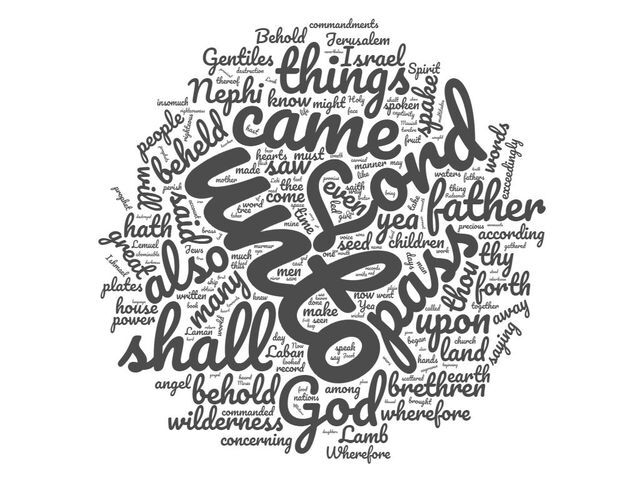
2 Nephi

Enos
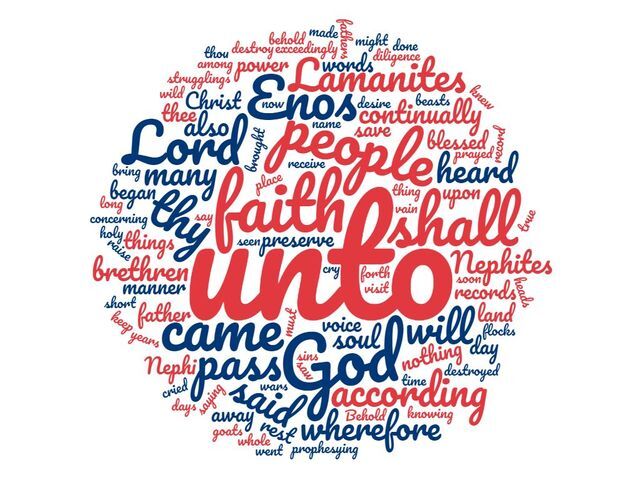
Mosiah
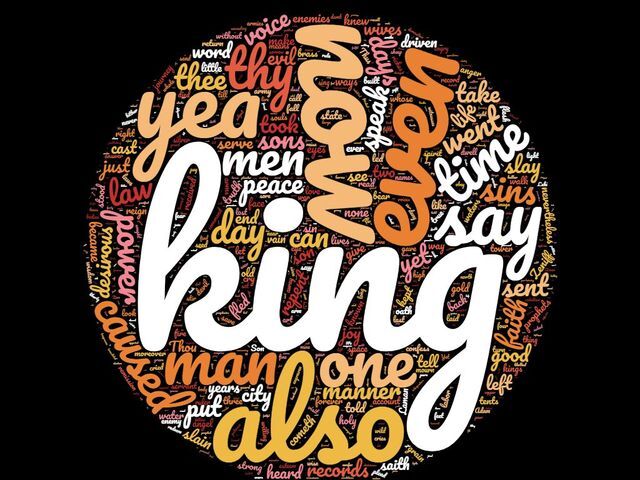
Alma
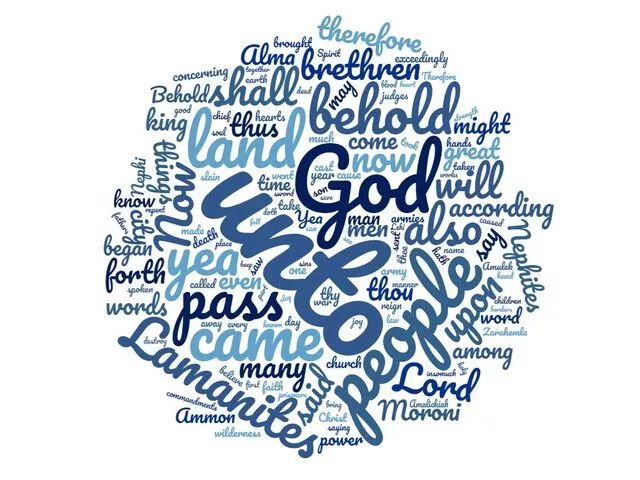
3 Nephi
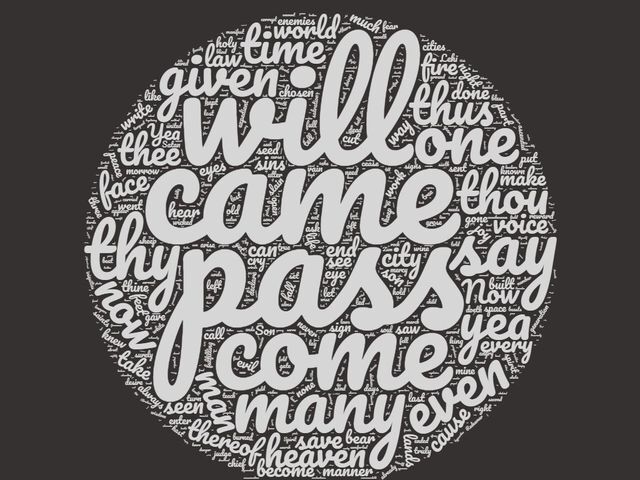
Ether
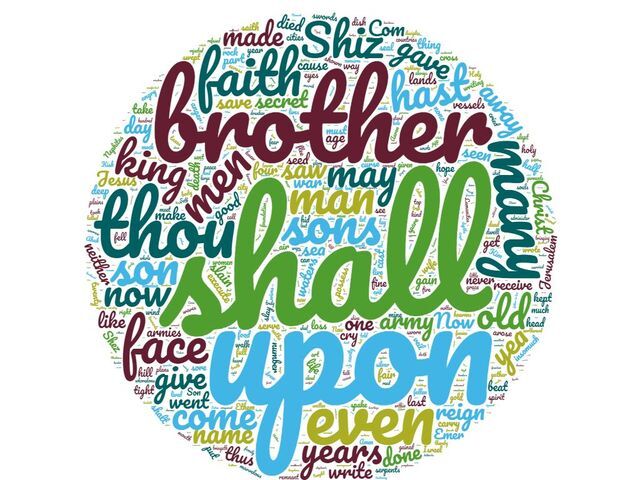
The Most Common Phrase
Did you know “it came to pass” appears in the Book of Mormon a whopping 1,353 times? While other powerful phrases in the Book of Mormon—such as the second- and third-most-common phrases “of the Lord” (which appears 478 times) and “I say unto you” (which appears 260 times)—speak of the divinity of this sacred record, showing that it truly is “of the Lord” and shares His words spoken directly to us, “it came to pass” is often a little harder for Latter-day Saints to grasp.
But as Dr. Taylor Halverson, a BYU Teaching and Learning Consultant, observed, this phrase signifies more than just a transition or a way to move along events. The phrase itself is rooted in the Hebrew name for Jesus Christ, the great I Am. As Halverson writes:
In Hebrew, the phrase “it came to pass” is built on the same Hebrew root word for the personal name of God: Yahweh. . . .
When we read “it came to pass” we see God’s presence, His love, His concern, His energy, His knowledge, His direction, His guidance. Truly, God, as Yahweh, is the One who makes all that is and brings to pass all that is necessary for our eternal salvation.
“It came to pass” is not a meaningless phrase. Instead, its very makeup testifies of our Savior, Jesus Christ, showing us the source of our faith and all we do. Its consistency and frequency throughout the Book of Mormon testifies that this sacred record is the word of our Heavenly Father and His Son, Jesus Christ, as They testify to us in the most intimate, clear, and personal language. Truly, the Book of Mormon is a divine book, one that can speak straight to our souls and fill us with the love and light of Christ.
Editor’s note: This article was originally published on LDSLiving.com in October 2017.

